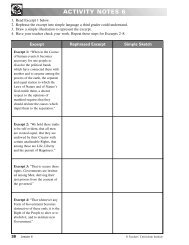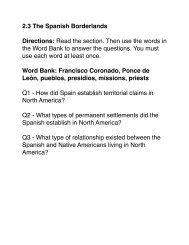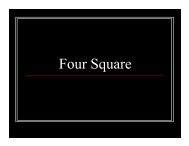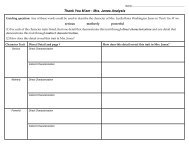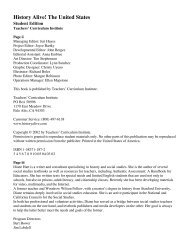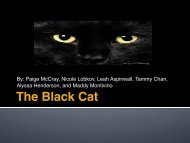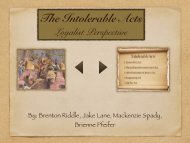Chapter 6: The Declaration of Independence Guiding Question ...
Chapter 6: The Declaration of Independence Guiding Question ...
Chapter 6: The Declaration of Independence Guiding Question ...
You also want an ePaper? Increase the reach of your titles
YUMPU automatically turns print PDFs into web optimized ePapers that Google loves.
6.6 <strong>The</strong> Final Break<br />
On July 1, 1776, the Second Continental Congress met in Philadelphia’s State House to debate<br />
independence. By noon, the temperature outside had soared into the nineties, and a thunderstorm<br />
was gathering. Inside the State House, emotions were equally hot and stormy. By the end <strong>of</strong> the<br />
day, the issue was still undecided.<br />
<strong>The</strong> next day was cooler and calmer. On July 2, 12 colonies voted for independence. New York<br />
cast no vote.<br />
No delegate was more excited about the colonies’ decision than John Adams. He wrote to his<br />
wife Abigail, “<strong>The</strong> second <strong>of</strong> July…will be celebrated by succeeding generations…with pomp<br />
and parade, with shows, games, sports, guns, bells, bonfires and illuminations, from one end <strong>of</strong><br />
the continent to the other, from this time forward forevermore.”<br />
Debate over Slavery<br />
Adams was wrong about the date that would be celebrated as America’s birthday, but only<br />
because Congress decided to revise Jefferson’s declaration. Most <strong>of</strong> the delegates liked what they<br />
read, except for a passage on slavery. Jefferson had charged King George with violating the<br />
“sacred rights <strong>of</strong> life and liberty…<strong>of</strong> a distant people [by] carrying them into slavery.”<br />
Almost no one liked this passage. Southerners feared that it might lead to demands to free the<br />
slaves. Northerners worried that New England merchants, who pr<strong>of</strong>ited from the slave trade,<br />
might be <strong>of</strong>fended. Even delegates who opposed slavery felt that it was unfair to blame the king<br />
for enslaving Africans. <strong>The</strong> passage was struck out.<br />
<strong>Independence</strong> Day<br />
On July 4, the delegates approved a final version <strong>of</strong> the <strong>Declaration</strong> <strong>of</strong> <strong>Independence</strong>. One by<br />
one, they stepped forward to sign it. In doing so, they pledged to support independence with “our<br />
lives, our fortunes, and our sacred honor.”<br />
This was a serious pledge. Every signer knew that he was committing an act <strong>of</strong> treason against<br />
Great Britain. If the new “United States <strong>of</strong> America” failed to win its freedom, each <strong>of</strong> them<br />
could end up swinging from a hangman’s rope. Knowing this, Benjamin Franklin told the<br />
delegates, “We must all hang together. Or most assuredly we shall all hang separately.”<br />
Fast Fact<br />
• Slavery was not mentioned in the <strong>Declaration</strong> <strong>of</strong> <strong>Independence</strong> because the slave trade was<br />
important to the economy <strong>of</strong> many <strong>of</strong> the colonies. In a triangular trade, rum and iron were<br />
shipped from New England to West Africa. In West Africa, these products were exchanged for<br />
slaves. <strong>The</strong>n the slaves were taken to the West Indies (Caribbean), where they were traded for<br />
molasses and sugar. Finally, the molasses and sugar were brought back to New England.



